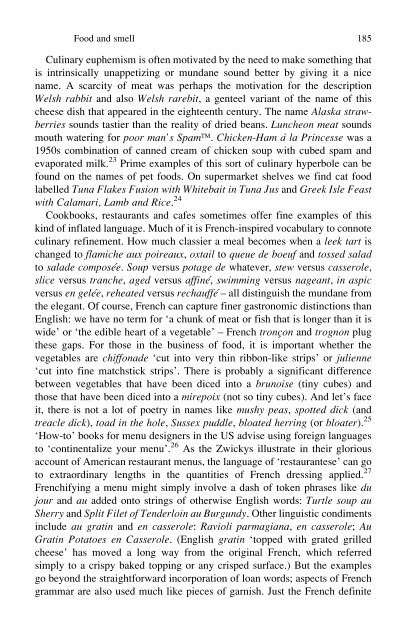Forbidden Words: Taboo and the Censoring of Language
Forbidden Words: Taboo and the Censoring of Language
Forbidden Words: Taboo and the Censoring of Language
You also want an ePaper? Increase the reach of your titles
YUMPU automatically turns print PDFs into web optimized ePapers that Google loves.
Food <strong>and</strong> smell 185<br />
Culinary euphemism is <strong>of</strong>ten motivated by <strong>the</strong> need to make something that<br />
is intrinsically unappetizing or mundane sound better by giving it a nice<br />
name. A scarcity <strong>of</strong> meat was perhaps <strong>the</strong> motivation for <strong>the</strong> description<br />
Welsh rabbit <strong>and</strong> also Welsh rarebit, a genteel variant <strong>of</strong> <strong>the</strong> name <strong>of</strong> this<br />
cheese dish that appeared in <strong>the</strong> eighteenth century. The name Alaska strawberries<br />
sounds tastier than <strong>the</strong> reality <strong>of</strong> dried beans. Luncheon meat sounds<br />
mouth watering for poor man’s SpamÔ. Chicken-Ham à la Princesse was a<br />
1950s combination <strong>of</strong> canned cream <strong>of</strong> chicken soup with cubed spam <strong>and</strong><br />
evaporated milk. 23 Prime examples <strong>of</strong> this sort <strong>of</strong> culinary hyperbole can be<br />
found on <strong>the</strong> names <strong>of</strong> pet foods. On supermarket shelves we find cat food<br />
labelled Tuna Flakes Fusion with Whitebait in Tuna Jus <strong>and</strong> Greek Isle Feast<br />
with Calamari, Lamb <strong>and</strong> Rice. 24<br />
Cookbooks, restaurants <strong>and</strong> cafes sometimes <strong>of</strong>fer fine examples <strong>of</strong> this<br />
kind <strong>of</strong> inflated language. Much <strong>of</strong> it is French-inspired vocabulary to connote<br />
culinary refinement. How much classier a meal becomes when a leek tart is<br />
changed to flamiche aux poireaux, oxtail to queue de boeuf <strong>and</strong> tossed salad<br />
to salade composée. Soup versus potage de whatever, stew versus casserole,<br />
slice versus tranche, aged versus affiné, swimming versus nageant, in aspic<br />
versus en gelée, reheated versus rechauffé – all distinguish <strong>the</strong> mundane from<br />
<strong>the</strong> elegant. Of course, French can capture finer gastronomic distinctions than<br />
English: we have no term for ‘a chunk <strong>of</strong> meat or fish that is longer than it is<br />
wide’ or ‘<strong>the</strong> edible heart <strong>of</strong> a vegetable’ – French tronçon <strong>and</strong> trognon plug<br />
<strong>the</strong>se gaps. For those in <strong>the</strong> business <strong>of</strong> food, it is important whe<strong>the</strong>r <strong>the</strong><br />
vegetables are chiffonade ‘cut into very thin ribbon-like strips’ or julienne<br />
‘cut into fine matchstick strips’. There is probably a significant difference<br />
between vegetables that have been diced into a brunoise (tiny cubes) <strong>and</strong><br />
those that have been diced into a mirepoix (not so tiny cubes). And let’s face<br />
it, <strong>the</strong>re is not a lot <strong>of</strong> poetry in names like mushy peas, spotted dick (<strong>and</strong><br />
treacle dick), toad in <strong>the</strong> hole, Sussex puddle, bloated herring (or bloater). 25<br />
‘How-to’ books for menu designers in <strong>the</strong> US advise using foreign languages<br />
to ‘continentalize your menu’. 26 As <strong>the</strong> Zwickys illustrate in <strong>the</strong>ir glorious<br />
account <strong>of</strong> American restaurant menus, <strong>the</strong> language <strong>of</strong> ‘restaurantese’ can go<br />
to extraordinary lengths in <strong>the</strong> quantities <strong>of</strong> French dressing applied. 27<br />
Frenchifying a menu might simply involve a dash <strong>of</strong> token phrases like du<br />
jour <strong>and</strong> au added onto strings <strong>of</strong> o<strong>the</strong>rwise English words: Turtle soup au<br />
Sherry <strong>and</strong> Split Filet <strong>of</strong> Tenderloin au Burgundy. O<strong>the</strong>r linguistic condiments<br />
include au gratin <strong>and</strong> en casserole: Ravioli parmagiana, en casserole; Au<br />
Gratin Potatoes en Casserole. (English gratin ‘topped with grated grilled<br />
cheese’ has moved a long way from <strong>the</strong> original French, which referred<br />
simply to a crispy baked topping or any crisped surface.) But <strong>the</strong> examples<br />
go beyond <strong>the</strong> straightforward incorporation <strong>of</strong> loan words; aspects <strong>of</strong> French<br />
grammar are also used much like pieces <strong>of</strong> garnish. Just <strong>the</strong> French definite

















